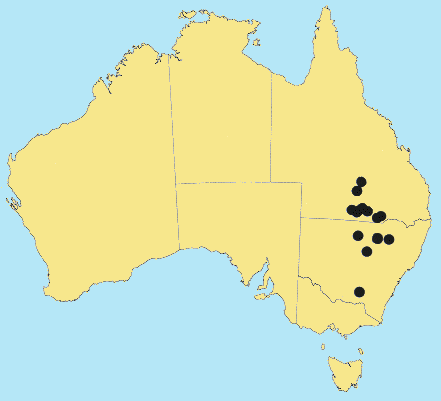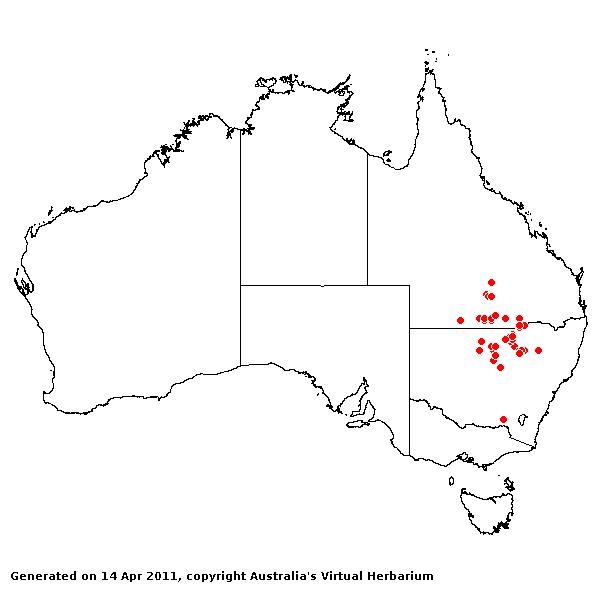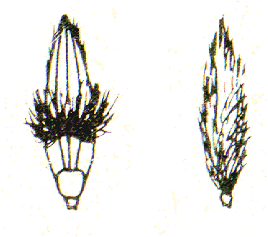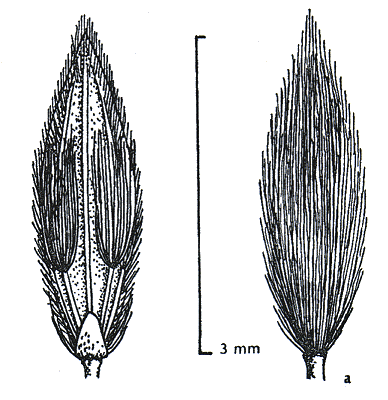Digitaria hubbardii Henrard. Monogr.
Digitaria 334 (1950).
Classification. (GPWG 2001) : Subfamily
Panicoideae. Paniceae.
Type of Basionym or
Protologue Information: HT: Whittet 2, Australia (K; IT: NSW).
Recent synonyms:
D. neurachnoides.
Key references
(books and floras): [2002] D.Sharp & B.K.Simon, AusGrass, Grasses of
Australia, [2008] S.W.L.Jacobs, R.D.B.Walley & D.J.B.Wheeler, Grasses
of New South Wales (217).
Illustrations:
[2008] S.W.L.Jacobs, R.D.B.Whalley & D.J.B.Wheeler, Grasses of New South
Wales, 4th edn (217).
Habit. Perennial. Rhizomes present. Stolons absent. Culms erect or
geniculately ascending, 20–60 cm tall, 3–10 -noded. Mid-culm internodes
glabrous. Mid-culm nodes glabrous or pubescent. Lateral branches sparsely
branched or branched. Leaf-sheaths antrorsely scabrous, glabrous on surface.
Leaf-sheath auricles absent. Ligule an eciliate membrane, 1 mm long, truncate
or obtuse. Leaf-blades flat or involute, 1.8–10 cm long, 1–3 mm wide.
Leaf-blade surface scabrous, indumented.
Inflorescence.
Inflorescence subdigitate, with racemose branches. Racemes 3–4, spreading, 2.5–8
cm long. Central inflorescence axis 1.5–4 cm long.
Spikelets.
Spikelets pedicelled, 2 in the cluster. Fertile spikelets 2-flowered, the lower
floret barren (rarely male), the upper fertile, comprising 1 basal sterile
florets, comprising 1 fertile floret(s), without rachilla extension,
lanceolate, dorsally compressed, 2.6–3.4 mm long. Rhachilla internodes brief up
to lowest fertile floret.
Glumes. Glumes
thinner than fertile lemma. Lower glume ovate or orbicular, membranous. Upper
glume lanceolate, 2.2–2.8 mm long, membranous, without keels, 3 -nerved. Upper
glume surface indumented. Florets. Basal sterile florets 1, barren,
without significant palea. Lemma of lower sterile floret 100 % of length of
spikelet, membranous, 5–7 -nerved.
Fertile lemma 1.9–2.5 mm
long, without keel. Lodicules present.
Continental
Distribution: Australasia.
Australian
Distribution: Queensland, New South Wales.
Queensland:
Maranoa, Warrego. New South Wales: South-Western Slopes, North-Western
Plains.
Notes.
The transverse line of lower lemma pubescence which characterizes D.
hubbardii can be found to a limited extent in D. ammophila and D.
hystrichoides.
In semi-arid shrub
woodlands, shrub steppe shrublands, acacia shrublands, arid hummock grasslands,
and tropical sub-humid grasslands. Flowers mostly Feb.-Apr.





